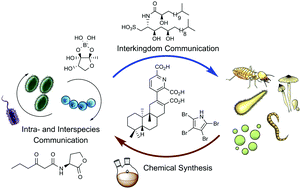Total synthesis and functional analysis of microbial signalling molecules
Abstract
Communication is essential for all domains of life. Bacteria use a plethora of small molecules to sense and orchestrate intra- and interspecies communication. Within this review, we will discuss different groups of signalling molecules, including autoinducers, virulence factors and morphogenic substances. On selected examples, we will shortly discuss their ecological roles and biosynthetic proposals. The major part of this review will focus on a systematic overview of the different synthetic methods applied towards the synthesis of signalling molecules and derivatives thereof. The described examples highlight the importance of organic synthetic method development and diversity-oriented total syntheses for structure verification, structure–function analysis and target identification.



 Please wait while we load your content...
Please wait while we load your content...